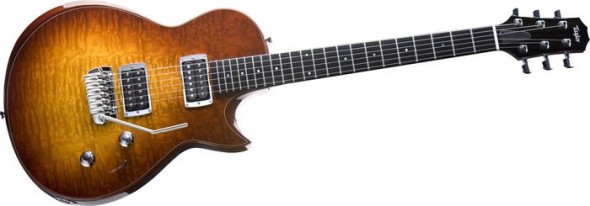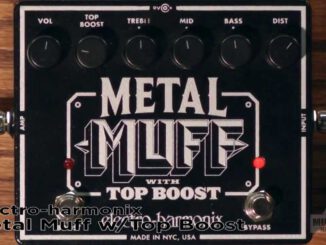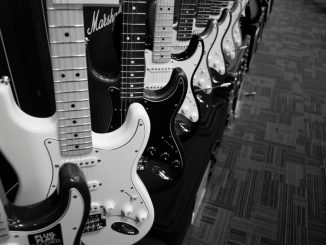
Decades have passed since Taylor Guitars emerge as a force in the world of acoustic guitars by overcoming the “it’s right because we’ve always done it this way” mentality of its long-established competition. Taylor demonstrated that new technology could be used to create instruments that looked and sounded as good or better than those made “the old-fashioned way,” with a level of consistency that many traditionalists would trade his bone nut for.
It took a generation for the company to turn its attention to the electric guitar market, but Taylor’s approach to its growing line of solidbodies has followed the pattern established with its acoustic instruments: Create a player’s guitar that’s both familiar and innovative–while rethinking and refining every possible detail.
Taylor Solid Body – Solid Start
The latest member of Taylor’s Solidbody range is the SB-S1-T ($1,999), which stands for “Solidbody Standard Tremolo.” Right out of the case, the guitar felt and sounded like an old friend. As you might expect to form a single-cutaway guitar with two humbuckers, the dimensions are influenced by Gibson’s Les Paul. But this is no knockoff: Like Taylor’s acoustics, the SB-S1-T honors its forbears but possesses its own individual character.
The test guitar was adorned with a beautiful aged cherry burst finish that let the grain of its quilted maple top pop without overwhelming the wood’s natural beauty. The top and its finish add a discrete touch of flash, which balances nicely with the austere elegance of the ebony fingerboard’s dot inlays and the understated headstock. The neck, like the body, is made of Sapele mahogany-like wood with a honey grain that looks great under its clear finish. The model features a 24-7/8”-scale neck which couples to the body with Taylor’s innovative T-Lock neck joint, that offers the vibration transfer of a set neck with the utility and upper-fret access of a bolt-on. The 22 beefy electric frets are extremely well dressed; the 12” fretboard radius allows easy bends as well as comfortable access on those reaches to the lower strings.
Taylor Guitars – Tone Machine
The SB-S1-T’s pickups are a major part of the story, but I’d be remiss if I restricted the tonal discussion to the electronics. The test guitar was one of the best-sounding electric guitars I’ve ever played unplugged. The impressive balance of upper and lower mid-range is an important reason the Taylor offers such an array of tonal colors when amplified.
Taking advantage of that natural tone are two new humbuckers that use Alnico V magnets to capture the vintage flavor of the early “Patent Applied For” pickups. The bridge pickup is slightly hotter than its neck counterpart and offers a little more bite in the upper mids, just the thing to add twang and articulation on both clean and over-driven tones. While the Taylor offers an authentic take on the PAF theme, its blade-type five-way switch provides five distinct tones, offering serious players the versatility needed for 21st-century gigs and sessions.
As you’d expect, pickup positions 1 and 5 toggle between the front and back pickups in their respective full humbucking modes. From there, things get interesting: Position 2 gives you the inside coils of each humbucker in a hum-canceling mode that sounds impressively Strat-like, yet distinct in its own right. A little brighter than the same switch position on a guitar equipped with three single-coils, it delivers the sought-after “glass” sound without the watered-down-lite-beer flavor that typically plagues split-coil humbuckers. The middle position combines both coils of the neck pickup with the bridge pup’s inside coil for a wide, rich tone that’s great for hot, twangy leads or fat chords that retain their sonic detail. The fourth position calls up the two outside coils in series for ultra-wide string coverage and a uniquely huge sound that really rings.
It’s Under Control – Electric Guitar Controls
Although the SB-S1-T has only two knobs (master volume, master tone), each offers plenty of usable range. The volume control works especially well for players who like to adjust their overdrive with the guitar and amp, rather than a pedal. It cuts the output gain gradually to allow for subtle adjustments–and does so without killing the highs. That allowed me to push the amp’s gain higher than normal and use the knob, in combination with the pickup selector, to dial-up clean, crunch, and true overdrive sounds. The tone knob is also effective; for the first two-thirds of its rotation, it works like a standard circuit. The last third of the knob’s travel brings out more midrange, which is especially great when the bridge humbucker is driving the amp (think Truth-era Jeff Beck).
Taylor Guitars – Turnin’ Bridge
What sets the SB-S1-T apart from other Taylor electrics is its new fulcrum vibrato bridge. Taylor did its typical rethink of an established design by changing the balance point of the bridge to make it more 50/50 than traditional floating bridges. The result is easy action in both directions, and tension that’s good for both subtle vibrato and more drastic dive-bombing effects. One thing I noticed is that the pitch changes a little faster than on my Strats, so more economical movement of the bridge produces similar results. With its bridge mated to Taylor locking tuners and a bone nut specially cut to reduce friction, the SB-S1-T stayed in tune impressively well.
Taylor Made Guitars
Great tone, elegant looks, fast action, and solid intonation make the SB-S1-T a working guitar player’s delight. If you’re tired of hauling out three guitars just to get through one set, strap one on: It will get you through the night–and well beyond. — Price: $1,999.00





Be the first to comment